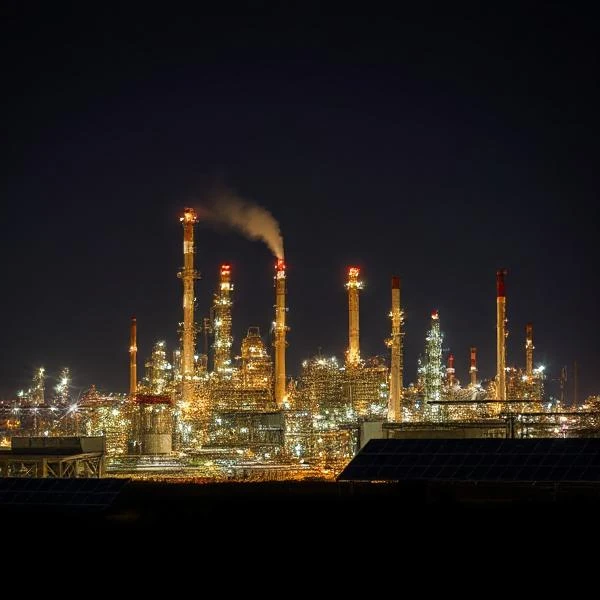
Oil formed beneath the Earth's surface after the decomposition of marine microorganisms over millions of years. Conventional reserves are limited and extraction is becoming increasingly energy-intensive, which is measured by the EROEI factor (Energy Return on Energy Invested) ...
Oil, the backbone of the global economy for over a century, faces unprecedented challenges. According to projections, global demand could peak before 2030, with an annual decline of \(2.5\%\) thereafter. This transition is explained by three main factors: the depletion of reserves, environmental concerns, and the growing competitiveness of renewable energy.
N.B.:
The EROEI factor (Energy Returned On Energy Invested) is a key indicator for assessing the viability and efficiency of an energy source. It measures the ratio between the energy produced by a source and the energy spent to extract, transform, and distribute it.
| Country | Estimated production (Mb/d) | Global share (%) |
|---|---|---|
| United States | 11.0 | 15 |
| Saudi Arabia | 10.5 | 14 |
| Russia | 10.0 | 13 |
| Canada | 5.0 | 7 |
| China | 4.0 | 5 |
| Iraq | 4.5 | 6 |
| United Arab Emirates | 3.0 | 4 |
| Iran | 3.5 | 5 |
| Kuwait | 2.5 | 3 |
| Brazil | 3.0 | 4 |
Source: IEA, World Energy Outlook 2024 and BP Statistical Review of World Energy 2025.
Solar and wind energy have experienced exponential growth, with costs falling fivefold since 2010. The economic equation is becoming unavoidable: \(C_{renewable} < C_{fossil}\) in most cases. Global investments in clean energy exceeded $1,000 billion in 2024, compared to $650 billion for fossil fuels.
| Energy | Global share (%) | Average cost per megawatt ($/MWh) | CO2 emissions (g/kWh) |
|---|---|---|---|
| Oil | 30 | 120 $ | 730 |
| Natural gas | 25 | 80 $ | 490 |
| Coal | 20 | 60 $ | 950 |
| Nuclear | 10 | 100 $ | 12 |
| Solar | 8 | 45 $ | 40 |
| Wind | 6 | 50 $ | 15 |
| Hydropower | 1 | 70 $ | 24 |
Source: IEA, World Energy Outlook 2024 and BP Statistical Review of World Energy 2025.
Global oil production has peaked or is peaking in several regions. Substitution with renewable energy and storage technologies is essential to reduce the global carbon budget and limit climate warming.
| Event | Energy impact | Economic impact | Comments |
|---|---|---|---|
| Global peak oil | Decrease in net energy flow | Increase in costs and price volatility | Varies according to oil types and extraction techniques |
| Transition to solar and wind | Intermittent production requiring storage | High investments but creation of green jobs | Requires improvement of smart grids and batteries |
| Massive deployment of electric vehicles | Increase in electricity demand | Transformation of industries and infrastructures | Risk of grid overload without planning |
| Decarbonization of heavy industry | Reduction in fossil fuel use | Reduction in carbon costs but high initial investments | May require the use of green hydrogen or biomass |
| Geopolitical instability linked to fossil energies | Indirect impact on energy security | Risk of economic fluctuations and raw material prices | Transition can reduce dependence on imports |
Source: IEA, World Energy Outlook 2024 and BP Statistical Review of World Energy 2025.
The energy transition raises a central question: which sources can truly replace oil in our current economic and energy systems? Three main candidates stand out for their potential and physical constraints.
The answer is simple: No single source can replace oil in all its uses.
The combination of hydrogen, solar, and nuclear, with strong optimization of networks and storage, is the most realistic strategy to ensure a sustainable energy transition. This substitution will not be immediate and will depend as much on technological innovation as on global policies and investments. However, oil could remain a marginal production for specific uses, but its central role in the global economy will gradually disappear.
Hydrogen is often presented as the energy vector of the future. Produced by water electrolysis or from natural gas (with CO2 capture), it can store and transport energy. Its overall energy efficiency remains limited by the production-storage-transformation chain, and the EROEI factor is often lower than that of fossil fuels. Nevertheless, hydrogen is particularly suited to heavy transport, industry, and the decarbonization of sectors that are difficult to electrify.
Solar photovoltaic energy is experiencing exponential growth, with an average cost per megawatt often lower than that of fossil fuels. However, its production is intermittent, dependent on weather and the day-night cycle, which requires massive storage solutions (batteries, pumped storage, hydrogen). In the long term, combined with smart grids, it could replace a significant part of the current electricity demand met by oil and gas.
Civil nuclear power offers stable, continuous, and low-CO2 production. Its specific power and energy density are significantly higher than those of renewable energies. However, constraints related to waste, safety, and the initial cost of facilities limit its rapid deployment. Nuclear can, however, play a key role in replacing oil in electricity production and, indirectly, in producing decarbonized hydrogen.